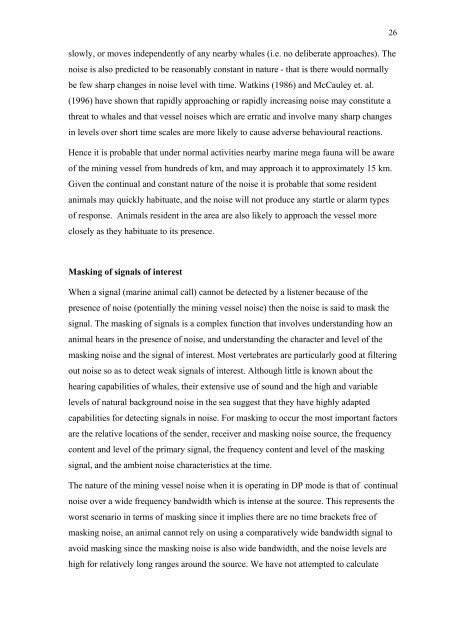Appendices 5-13 - Nautilus Cares - Nautilus Minerals
Appendices 5-13 - Nautilus Cares - Nautilus Minerals
Appendices 5-13 - Nautilus Cares - Nautilus Minerals
Create successful ePaper yourself
Turn your PDF publications into a flip-book with our unique Google optimized e-Paper software.
slowly, or moves independently of any nearby whales (i.e. no deliberate approaches). The<br />
noise is also predicted to be reasonably constant in nature - that is there would normally<br />
be few sharp changes in noise level with time. Watkins (1986) and McCauley et. al.<br />
(1996) have shown that rapidly approaching or rapidly increasing noise may constitute a<br />
threat to whales and that vessel noises which are erratic and involve many sharp changes<br />
in levels over short time scales are more likely to cause adverse behavioural reactions.<br />
Hence it is probable that under normal activities nearby marine mega fauna will be aware<br />
of the mining vessel from hundreds of km, and may approach it to approximately 15 km.<br />
Given the continual and constant nature of the noise it is probable that some resident<br />
animals may quickly habituate, and the noise will not produce any startle or alarm types<br />
of response. Animals resident in the area are also likely to approach the vessel more<br />
closely as they habituate to its presence.<br />
Masking of signals of interest<br />
When a signal (marine animal call) cannot be detected by a listener because of the<br />
presence of noise (potentially the mining vessel noise) then the noise is said to mask the<br />
signal. The masking of signals is a complex function that involves understanding how an<br />
animal hears in the presence of noise, and understanding the character and level of the<br />
masking noise and the signal of interest. Most vertebrates are particularly good at filtering<br />
out noise so as to detect weak signals of interest. Although little is known about the<br />
hearing capabilities of whales, their extensive use of sound and the high and variable<br />
levels of natural background noise in the sea suggest that they have highly adapted<br />
capabilities for detecting signals in noise. For masking to occur the most important factors<br />
are the relative locations of the sender, receiver and masking noise source, the frequency<br />
content and level of the primary signal, the frequency content and level of the masking<br />
signal, and the ambient noise characteristics at the time.<br />
The nature of the mining vessel noise when it is operating in DP mode is that of continual<br />
noise over a wide frequency bandwidth which is intense at the source. This represents the<br />
worst scenario in terms of masking since it implies there are no time brackets free of<br />
masking noise, an animal cannot rely on using a comparatively wide bandwidth signal to<br />
avoid masking since the masking noise is also wide bandwidth, and the noise levels are<br />
high for relatively long ranges around the source. We have not attempted to calculate<br />
26


